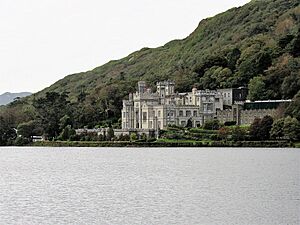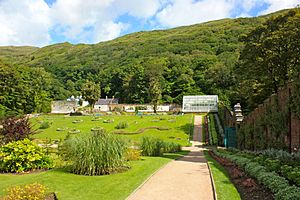Kylemore Abbey facts for kids
| Mainistir na Coille Móire | |

Kylemore Abbey with Doughruagh behind
|
|
| Monastery information | |
|---|---|
| Order | Benedictines |
| Established | 1920 |
| Diocese | Galway, Kilmacduagh and Kilfenora |
| People | |
| Founder(s) | Benedictine nuns from Ypres, Belgium |
| Architecture | |
| Status | Active |
| Style | Victorian |
| Site | |
| Location | Connemara, County Galway, Ireland |
| Coordinates | 53°33′42″N 9°53′22″W / 53.5617067°N 9.8894343°W |
| Public access | Yes |
Kylemore Abbey (which means Mainistir na Coille Móire in Irish) is a special place in Connemara, County Galway, Ireland. It is a Benedictine Monastery that started in 1920. The Abbey was built on the land of Kylemore Castle.
Benedictine nuns, who are a group of religious women, founded the Abbey. They came from Belgium because of World War I. Today, Kylemore Abbey is still a Benedictine monastery. It also welcomes many visitors as one of Ireland's top attractions. The Kylemore Trust looks after the Abbey and its important history.
Contents
History of Kylemore Abbey
How Kylemore Began
Kylemore Castle was built in 1868. It was a private home for a rich family. The family belonged to Mitchell Henry, a doctor from London. His family made textiles in England.
Mitchell Henry and his wife Margaret visited Ireland for their honeymoon. They loved the area and bought land there. He later became a politician. He was a Member of Parliament (MP) for County Galway from 1871 to 1885.
Building Kylemore Castle
The castle was designed by James Franklin Fuller. About one hundred men worked for four years to build it. The castle was very big, covering about 40,000 square feet. It had over seventy rooms. The main walls were very thick, about two to three feet.
The front of the castle was 142 feet wide. It was made of granite from Dalkey and limestone from Ballinasloe. The castle had 33 bedrooms and 4 bathrooms. It also had many sitting rooms, a ballroom, and a library. There were also rooms for the servants who worked there.
Sadly, Margaret Henry died in 1874. She got sick during a trip to Egypt. After her death, Mitchell Henry spent less time at Kylemore. He built a beautiful Gothic chapel and a family tomb to remember her. Margaret, Mitchell, and a great-grandnephew are buried there.
Mitchell Henry later returned to England. In 1903, the castle was sold. The Duke and Duchess of Manchester bought it. They lived there for several years. But they had to sell the castle because of money problems.
The Benedictine Nuns Arrive
The Benedictine nuns who live at Kylemore have a long history. Their community started in Brussels in 1598. Later, they moved to Ghent and then to Ypres in Belgium. Many Irish noblewomen joined the Abbey in Ypres.
In 1920, the nuns had to leave Ypres. Their Abbey was bombed during World War I. Soldiers from the Royal Munster Fusiliers helped them escape. They went to England first. Then, in 1920, they bought Kylemore Castle and its lands.
The nuns started a farm on the estate. They raised animals and grew vegetables. Kylemore Abbey became an important place for jobs in the area.
The nuns also opened a boarding school for girls in 1923. They had a day school for local girls too. This school was very important for girls in the area for almost a century. However, it closed in 2010. Since then, the nuns have started new educational and retreat activities.
In July 2022, Kylemore Abbey joined the English Benedictine Congregation. This is a larger group of Benedictine communities.
Kylemore Abbey and University of Notre Dame
Since 2015, Kylemore Abbey has worked with the University of Notre Dame. This is a university from the United States. The Abbey hosts special programs for Notre Dame students. The university also helped to fix up parts of the Abbey.
The student programs began in 2016. About 100 students came to Kylemore. Important people attended the opening ceremony. These included university leaders and ambassadors. The university offers business courses and art classes there. Famous flute player Sir James Galway even taught a class at Kylemore.
A special program called The Kylemore Abbey Biodiversity Stewardship Programme started in 2021. It works with the University of Galway. Students study the plants and animals on the Kylemore estate.
Beautiful Gardens
The Kylemore estate has large, beautiful Victorian Gardens. These gardens have been open to visitors since the 1970s. People can take tours and enjoy nature walks.
The Benedictine nuns have worked hard to restore the gardens and the church. They used donations and local craftspeople. The gardens include a Kitchen Garden and a flower garden. The original walled garden was designed in 1870. A full restoration of the gardens began in 1995.
Kylemore Abbey in the Media
Kylemore Abbey has been shown on TV. It was featured in the UK cooking show Two Fat Ladies in 1998. The hosts cooked dinner for the Benedictine nuns.
In 2020, Kylemore Abbey and the nuns were on RTE's Nationwide TV program. This celebrated 100 years of the Benedictine order at the Abbey. Kylemore also appeared in Heaven Made. This show follows nuns and monks making traditional gifts.
See also
 In Spanish: Abadía de Kylemore para niños
In Spanish: Abadía de Kylemore para niños
- List of abbeys and priories in Ireland (County Galway)
- List of tourist attractions in Ireland





